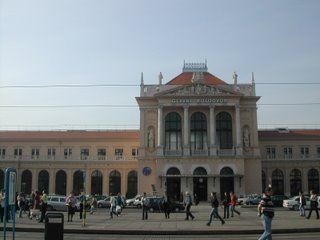The lower new town of Zagreb, off the hillside-cliff defense area, is cosmopolitan with parks and grand statues and great Viennese-style avenues and buildings, for business. Days of the old Austro-Hungarian Empire.
 Railroad Station, Zagreb, Croatia
Railroad Station, Zagreb, Croatia
The huge old (cloak and dagger?) railroad station in Zagreb has been a main stop for passengers coming from Vienna and moving on to Belgrade or elsewhere, and back.
You can see the influence of the old Austro-Hungarian Empire in most all of the buildings and statuary. The tiled roof is on St. Mark's. We found more people who spoke German than English. See fine photo gallery at www.pbase.com/ralf/zagreb&page=all.
 St. Mark's Church, Zagreb, Croatia
St. Mark's Church, Zagreb, Croatia
There are two main churches: This, St. Mark's Church; it is first documented in the 12th Century, Romanesque. The roof tiles form the coats of arms of Croatia, Dalmatia (the coastal region), Zagreb and Slavonia (the western agricultural region, see ://www.croatiatraveller.com/Slavonia/Slavonia.htm).
Then there is the Cathedral of St. Stephen, a more traditional Gothic-looking structure.
In the Cathedral of St. Stephen is the burial place for Cardinal Stepinac, whose activities during WWII are a discussion point for those concerned with the role of church officials in wars. Do you stand aside, and condone by passivity the genocides and other atrocities, or do you give up your life for your friends?
Cardinal Stepinac kept his life, and offered only to convert the Orthodox headed to their deaths at the hands of the Ustache. He did not stop or try to stop the executions.
For a favorable review of what Cardinal Stepinac decided and when, see www.hic.hr/books/stepinac/english/second/. For a less favorable account, see www.philologos.org/bpr/files/Vatican/vs001a. Fine minds differ.
Here is St. George, battling the perpetual dragon. Moisture drips from his toe, but this is not seen as miraculous as in some other religious statuary. See example at
Bosnia Road Ways, Medjugorje site .
 St. George and the Dragon, Zagreb park, Croatia
Dragons.
St. George and the Dragon, Zagreb park, Croatia
Dragons. The earliest "known" dragon may be at Mesopotamia, from the time of King Nebuchadnezzar.
What traces of what led to the nearly global idea of hte dragon. Is it just a kind of dinosaur.
Collateral and unrecoverable damage caused by wars over the centuries. Is there any archeological evidence of anything left there, after Operation Iraqi "Freedom." See information on collections at www.dia.org/collections/ancient/mesopotamia/31.25.
Dragon forms were also in Egypt, see www.ancientworlds.net/aw/Article/799168, and in various eastern and western cultures, see www.draconika.com/culture.php.
More on dragons: A TV show (history channel? sponsored by the army??) recently, in September 2006, said that dragons were also in Mexico, Alaska (!) . and we have seen the dragon boats in Viking cultures. Were they real once? Here is the story of a knight and the dragon, and saving the lady, from Libya: www.kellscraft.com/stgeorge.
 Miragoj Cemetery, Covered Gallery, Zagreb, Croatia (Orthodox; some German, from WWII)
Miragoj Cemetery, Covered Gallery, Zagreb, Croatia (Orthodox; some German, from WWII)
Miragoj Cemetery. This has been a heavily Orthodox area, and the big Mirogoj cemetery, just outside Zagreb, has many if not almost equal Cyrilic alphabet monuments, or other Orthodox symbols.
There is a large outdoor cemetery, of course, with walkways, and photographs of the deceased on the stones, embedded, or otherwise attached.
 Miragoj Cemetery, Gallery, Zagreb, Croatia
Miragoj Cemetery, Gallery, Zagreb, Croatia
There is a former Croatian president here, Mr. Tudjman, and artists, literary figures, professionals. Their locations are mapped; or just follow a tour group.
One travel site has little on Mirogoj, and asks for input, but their motto is something like, find what is true, and then travel to see it. See www.tripadvisor.com/. We do the opposite - who says what is true and why? Go and find it out yourself.
There also German soldiers from WWII, interred with a carefully alphabetized common marker, with names and full birth and death dates.
.
 Miragoj Cemetery, German section WWII, Zagreb, Croatia
Miragoj Cemetery, German section WWII, Zagreb, Croatia
 Railroad Station, Zagreb, Croatia
Railroad Station, Zagreb, Croatia St. Mark's Church, Zagreb, Croatia
St. Mark's Church, Zagreb, Croatia St. George and the Dragon, Zagreb park, Croatia
St. George and the Dragon, Zagreb park, Croatia Miragoj Cemetery, Covered Gallery, Zagreb, Croatia (Orthodox; some German, from WWII)
Miragoj Cemetery, Covered Gallery, Zagreb, Croatia (Orthodox; some German, from WWII) Miragoj Cemetery, Gallery, Zagreb, Croatia
Miragoj Cemetery, Gallery, Zagreb, Croatia Miragoj Cemetery, German section WWII, Zagreb, Croatia
Miragoj Cemetery, German section WWII, Zagreb, Croatia